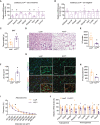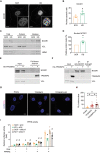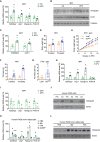Autophagy-mediated NCOR1 degradation is required for brown fat maturation and thermogenesis
- PMID: 35947488
- PMCID: PMC9980505
- DOI: 10.1080/15548627.2022.2111081
Autophagy-mediated NCOR1 degradation is required for brown fat maturation and thermogenesis
Erratum in
-
Correction.Autophagy. 2025 Jun;21(6):i. doi: 10.1080/15548627.2022.2123145. Epub 2022 Sep 14. Autophagy. 2025. PMID: 36102791 Free PMC article. No abstract available.
Abstract
Brown adipose tissue (BAT) thermogenesis affects energy balance, and thereby it has the potential to induce weight loss and to prevent obesity. Here, we document a macroautophagic/autophagic-dependent mechanism of peroxisome proliferator-activated receptor gamma (PPARG) activity regulation that induces brown adipose differentiation and thermogenesis and that is mediated by TP53INP2. Disruption of TP53INP2-dependent autophagy reduced brown adipogenesis in cultured cells. In vivo specific-tp53inp2 ablation in brown precursor cells or in adult mice decreased the expression of thermogenic and mature adipocyte genes in BAT. As a result, TP53INP2-deficient mice had reduced UCP1 content in BAT and impaired maximal thermogenic capacity, leading to lipid accumulation and to positive energy balance. Mechanistically, TP53INP2 stimulates PPARG activity and adipogenesis in brown adipose cells by promoting the autophagic degradation of NCOR1, a PPARG co-repressor. Moreover, the modulation of TP53INP2 expression in BAT and in human brown adipocytes suggests that this protein increases PPARG activity during metabolic activation of brown fat. In all, we have identified a novel molecular explanation for the contribution of autophagy to BAT energy metabolism that could facilitate the design of therapeutic strategies against obesity and its metabolic complications.
Keywords: Autophagy; brown adipose tissue; metabolism; obesity; thermogenesis.
Conflict of interest statement
No potential conflict of interest was reported by the author(s).
Figures








References
-
- Chouchani ET, Kazak L, Spiegelman BM.. New advances in adaptive thermogenesis: UCP1 and beyond. Cell Metab. 2019;29(1):27–37. - PubMed
-
- Nedergaard J, Cannon B. Brown adipose tissue as a heat-producing thermoeffector. Handb Clin Neurol. 2018;156:137–152. - PubMed
-
- Nedergaard J, Bengtsson T, Cannon B. Unexpected evidence for active brown adipose tissue in adult humans. Am J Physiol Endocrinol Metab. 2007;293(2):E444–52. - PubMed
Publication types
MeSH terms
Substances
Grants and funding
LinkOut - more resources
Full Text Sources
Other Literature Sources
Research Materials
